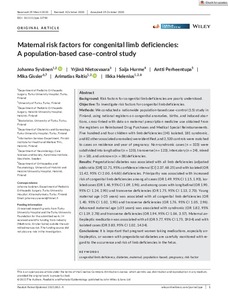Maternal risk factors for congenital limb deficiencies: A population-based case-control study
Nietosvaara Yrjänä; Raitio Arimatias; Perheentupa Antti; Gissler Mika; Hurme Saija; Syvänen Johanna; Helenius Ilkka
https://urn.fi/URN:NBN:fi-fe2021042826813
Tiivistelmä
Background
Risk factors for congenital limb deficiencies are poorly understood.
Objective
To investigate risk factors for congenital limb deficiencies.
Methods
We conducted a nationwide population-based case-control (1:5) study in Finland, using national registers on congenital anomalies, births, and induced abortions, cross-linked with data on maternal prescription medicine use obtained from the registers on Reimbursed Drug Purchases and Medical Special Reimbursements. Five hundred and four children with limb deficiencies (241 isolated, 181 syndromic, and 82 other associated anomalies) were identified, and 2,520 controls were matched to cases on residence and year of pregnancy. Non-syndromic cases (n = 323) were subdivided into longitudinal (n = 120), transverse (n = 123), intercalary (n = 24), mixed (n = 18), and unknown (n = 38) deficiencies.
Results
Pregestational diabetes was associated with all limb deficiencies (adjusted odds ratio [OR] 12.71, 95% confidence interval [CI] 2.37, 68.25) and with isolated (OR 11.42, 95% CI 2.00, 64.60) deficiencies. Primiparity was associated with increased risk of congenital limb deficiencies among all cases (OR 1.49, 95% CI 1.15, 1.93), isolated cases (OR 1.46, 95% CI 1.09, 1.96), and among cases with longitudinal (OR 1.90, 95% CI 1.24, 2.90) and transverse deficiencies (OR 1.75, 95% CI 1.13, 2.70). Young maternal age (<25 years) was associated with all congenital limb deficiencies (OR 1.40, 95% CI 1.02, 1.90) and transverse deficiencies (OR 1.76, 95% CI 1.05, 2.96). Advanced maternal age (>= 35 years) was associated with syndromic (OR 1.82, 95% CI 1.19, 2.78) and transverse deficiencies (OR 1.94, 95% CI 1.06, 3.57). Maternal antiepileptic medication was associated with all (OR 5.77, 95% CI 1.75, 19.04) and with isolated cases (OR 3.83, 95% CI 1.02, 14.34).
Conclusions
It is important that pregnant women taking medications, especially antiepileptics, or women with pregestational diabetes are carefully monitored with regard to the occurrence and risk of limb deficiencies in the fetus.
Kokoelmat
- Rinnakkaistallenteet [19207]
